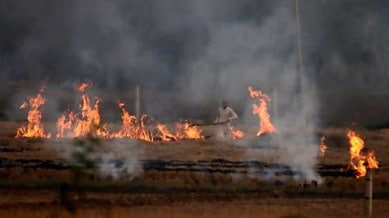Stay updated with the latest - Click here to follow us on Instagram
AQI at 331 in Capital, ‘very poor’ for 6th day: Vehicular pollution plagues Delhi despite dip in farm fires
Delhi's maximum daytime temperature Friday was recorded at 26.4 degrees Celsius, 0.4 degrees above normal, making it the second-lowest maximum of the season.

Notwithstanding the official end of the stubble-burning season in Punjab and Haryana, Delhi continued to reel under ‘very poor’ air quality for the sixth consecutive day Friday with the transport sector being the leading contributor.
Delhi recorded an average Air Quality Index (AQI) of 331 Friday, slightly worse than the 325 reported a day before.
monthly limit of free stories.
with an Express account.
The data from the Decision Support System (DSS) developed by the Indian Institute of Tropical Meteorology, Pune, shows a decline in stubble-burning contribution to Delhi’s particulate matter pollution. While stubble burning accounted for 5.8 per cent of the pollution on November 26, no data was provided for it on Wednesday or Thursday.
In Punjab and Haryana, the farm fire season comes to an end on November 30. The state governments track the farm fire counts until November 30 after which they stop recording the numbers as only sporadic events take place. Yet, the AQI in the Capital continued to remain in the ‘very poor’ category (see box) with the transport sector contributing the highest of 21.36 per cent.
In its pre-winter analysis of DSS data from October 12-27, the Centre for Science and Environment found local sources, led by vehicular pollution, to be the major cause of the rise in pollution in the Capital, despite a dip in farm fire counts during the same phase.
On Friday, 576 crop residue-burning events were detected by satellites, as per data from the Indian Agricultural Research Institute. The cases were the highest in Madhya Pradesh at 311, followed by 215 in Uttar Pradesh. Punjab and Haryana reported 32 and nine cases, respectively.
The wind direction also influences stubble-burning’s contribution to Delhi’s PM2.5 levels. According to weather experts, the contribution remains high on days when the wind direction is predominantly Northwesterly.
The lowest visibility reported in Delhi increased gradually from 300 metres on November 23 to 900 metres on November 27, stated the India Meteorological Department. It has forecast mainly clear skies with smog or shallow fog likely in the morning or evening or night. Owing to low wind speed, the pollutants will remain trapped close to the surface, and the air quality is forecast to be in the ‘very poor’ category in the coming days.
Delhi’s maximum daytime temperature Friday was recorded at 26.4 degrees Celsius, 0.4 degrees above normal, making it the second-lowest maximum of the season.